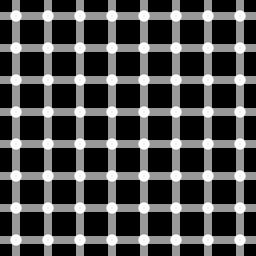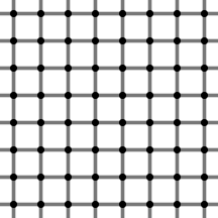Difference between revisions of "Grid illusion" - New World Encyclopedia
(Claimed) |
(Copied from wikipedia) |
||
| Line 1: | Line 1: | ||
{{Claimed}} | {{Claimed}} | ||
| + | [[Category:Politics and social sciences]] | ||
| + | [[Category:Psychology]] | ||
| + | |||
| + | |||
| + | [[Image:Grid illusion.svg|thumb|256px|right|An example of the Scintillating grid illusion]] | ||
| + | A '''grid illusion''' is any kind of [[grid]] that deceives a person's vision. The two most common types of grid illusions are '''Scintillating grid illusions''' and '''Hermann grid illusions'''. | ||
| + | ==Scintillating grid illusion== | ||
| + | The '''Scintillating grid illusion''' is an [[optical illusion]] when dots seem to appear and disappear at the intersections of two lines crossing each other vertically and horizontally. When a person keeps his or her eyes directly on a single intersection, the dot does not appear. A variation of the Scintillating illusion is the Hermann grid illusion (see section below). In the picture on the right, a person should see white dots turn black and then turning white again very fast. The dots disappear if one is too close or too far from the image. | ||
| + | |||
| + | ==Hermann grid illusion== | ||
| + | [[Image:Hermann grid illusion.svg|thumb|202px|left|A Hermann grid illusion. Shape position and color [[contrast (vision)|contrast]] converge to produce the illusion of spots at the intersections.]] | ||
| + | The '''Hermann grid illusion''' is an [[optical illusion]] reported by [[Ludimar Hermann]] in [[1870]] while, incidentally, reading [[John Tyndall]]'s ''Sound''. It is very similar to the Scintillating grid illusion. | ||
| + | |||
| + | Like the Scintillating grid illusion, when looking at a grid of black squares on a white (or light-colored) background, one will have the impression that there are "ghostlike" grey blobs at the intersections of the white lines. The grey blobs disappear when looking directly at an intersection. | ||
| + | |||
| + | [[Image:White grid illusion.svg|thumb|218px|right|Another type of Hermann grid illusion.]] | ||
| + | |||
| + | ==Differences between the Scintillating and Hermann grid illusions== | ||
| + | The difference between the Hermann grid illusion and the Scintillating illusion is that Scintillating illusions have dots already in place at the intersection, whereas there are no dots already in place at the intersections of Hermann grid illusions. However, since they are so similar, the two names are commonly switched around. | ||
| + | |||
| + | ==The cause of both Scintillating and Hermann grid illusions== | ||
| + | The effect of the optical illusion is commonly (and falsely) explained by a neural process called [[lateral inhibition]]. The intensity at a point in the visual system is not simply the result of a single [[sensory receptor|receptor]], but the result of a group of receptors called a [[receptive field]]. | ||
| + | |||
| + | In the center of the receptive field, the receptors act ''excitatory'' on the resulting signal, and the receptors in the surrounding area act ''inhibitory'' on the signal. Thus, since a point at an intersection is surrounded by more intensity than a point at the middle of a line, the intersection appears darker. In a person's eyes, the nerve cells of the retina associate and interact with each other, which results in the illusion that there are dots, when there really aren't. | ||
| + | |||
| + | This explanation has recently been successfully challenged by Janos Geier (see the [http://www.michaelbach.de/ot/lum_herGridCurved/index.html interactive counter example]). | ||
| + | |||
| + | ==References== | ||
| + | <!-- ---------------------------------------------------------- | ||
| + | See http://en.wikipedia.org/wiki/Wikipedia:Footnotes for a | ||
| + | discussion of different citation methods and how to generate | ||
| + | footnotes using the <ref>, </ref> and <reference /> tags | ||
| + | ----------------------------------------------------------- —> | ||
| + | <div class="references-small"> | ||
| + | <references /> | ||
| + | </div> | ||
| + | |||
| + | ==External links== | ||
| + | *[http://www.michaelbach.de/ot/lum_herGrid/index.html Refutation of classical explanation of Hermann Grid Illusion] | ||
| + | *[http://mathworld.wolfram.com/ScintillatingGridIllusion.html Scintillating Grid Illusion – Mathworld] | ||
| + | *[http://www.josef.org/scintillating.html Giant grid] | ||
| + | * [http://eefoof.com/image/10131 Large Hermann Grid Illusion] | ||
| + | |||
| + | |||
| + | |||
| + | |||
| + | |||
| + | {{Credits|Grid_illusion|115267816|}} | ||
Revision as of 21:34, 8 April 2007
A grid illusion is any kind of grid that deceives a person's vision. The two most common types of grid illusions are Scintillating grid illusions and Hermann grid illusions.
Scintillating grid illusion
The Scintillating grid illusion is an optical illusion when dots seem to appear and disappear at the intersections of two lines crossing each other vertically and horizontally. When a person keeps his or her eyes directly on a single intersection, the dot does not appear. A variation of the Scintillating illusion is the Hermann grid illusion (see section below). In the picture on the right, a person should see white dots turn black and then turning white again very fast. The dots disappear if one is too close or too far from the image.
Hermann grid illusion
The Hermann grid illusion is an optical illusion reported by Ludimar Hermann in 1870 while, incidentally, reading John Tyndall's Sound. It is very similar to the Scintillating grid illusion.
Like the Scintillating grid illusion, when looking at a grid of black squares on a white (or light-colored) background, one will have the impression that there are "ghostlike" grey blobs at the intersections of the white lines. The grey blobs disappear when looking directly at an intersection.
Differences between the Scintillating and Hermann grid illusions
The difference between the Hermann grid illusion and the Scintillating illusion is that Scintillating illusions have dots already in place at the intersection, whereas there are no dots already in place at the intersections of Hermann grid illusions. However, since they are so similar, the two names are commonly switched around.
The cause of both Scintillating and Hermann grid illusions
The effect of the optical illusion is commonly (and falsely) explained by a neural process called lateral inhibition. The intensity at a point in the visual system is not simply the result of a single receptor, but the result of a group of receptors called a receptive field.
In the center of the receptive field, the receptors act excitatory on the resulting signal, and the receptors in the surrounding area act inhibitory on the signal. Thus, since a point at an intersection is surrounded by more intensity than a point at the middle of a line, the intersection appears darker. In a person's eyes, the nerve cells of the retina associate and interact with each other, which results in the illusion that there are dots, when there really aren't.
This explanation has recently been successfully challenged by Janos Geier (see the interactive counter example).
ReferencesISBN links support NWE through referral fees
External links
- Refutation of classical explanation of Hermann Grid Illusion
- Scintillating Grid Illusion – Mathworld
- Giant grid
- Large Hermann Grid Illusion
Credits
New World Encyclopedia writers and editors rewrote and completed the Wikipedia article in accordance with New World Encyclopedia standards. This article abides by terms of the Creative Commons CC-by-sa 3.0 License (CC-by-sa), which may be used and disseminated with proper attribution. Credit is due under the terms of this license that can reference both the New World Encyclopedia contributors and the selfless volunteer contributors of the Wikimedia Foundation. To cite this article click here for a list of acceptable citing formats.The history of earlier contributions by wikipedians is accessible to researchers here:
The history of this article since it was imported to New World Encyclopedia:
Note: Some restrictions may apply to use of individual images which are separately licensed.

